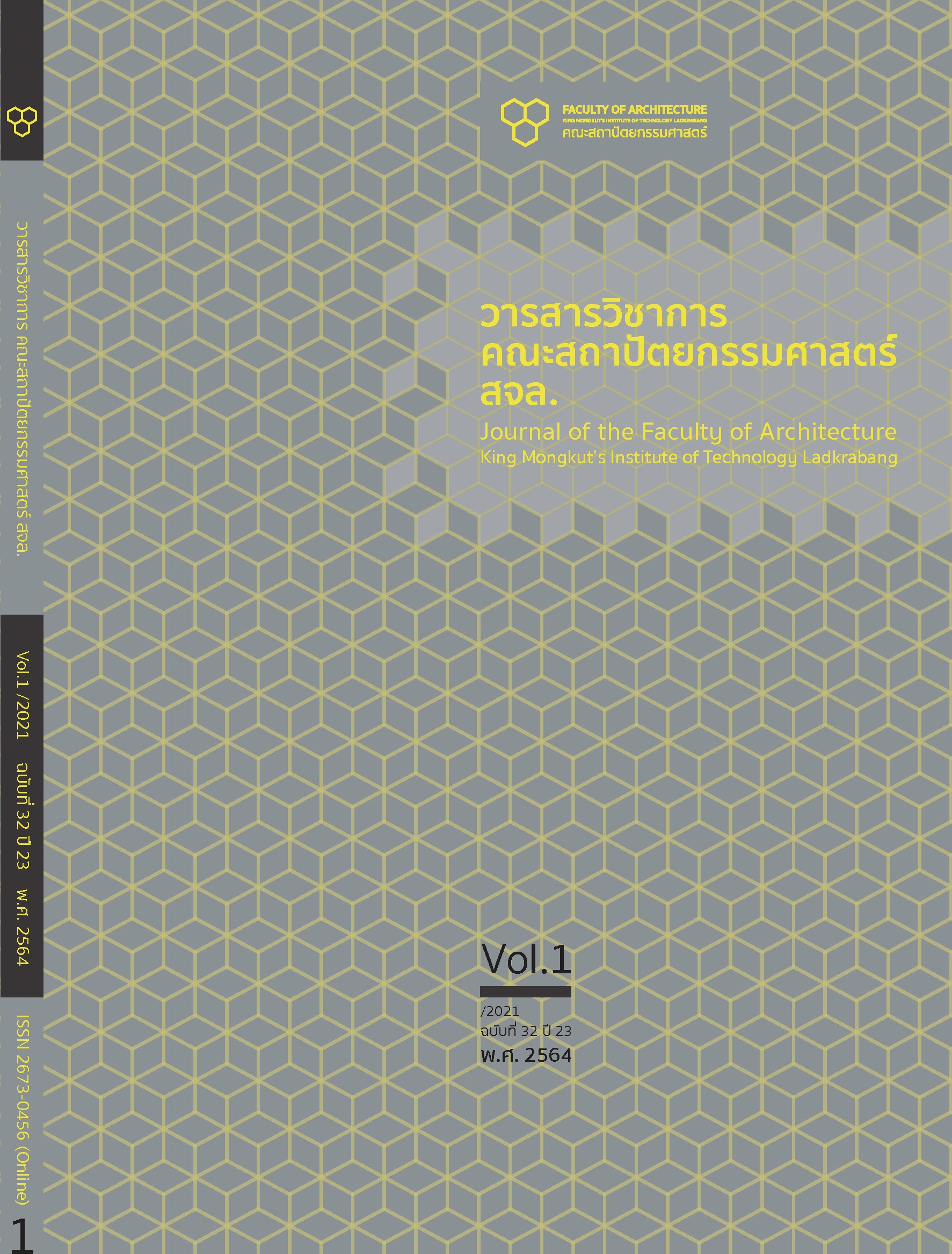The Activities and Physical Factors of Public Space in Nakhon Si Thammarat Old Town
Main Article Content
Abstract
This research aims at studying the use patterns and physical factors of the public spaces in Nakhon Si Thammarat Old Town, by studying the theories, meaning of public spaces, 3 types of activities in public spaces and 8 the physical factors affect to success in public space use. The research methods contain a site survey on a sampling of 19 public spaces that are categorized into 5 types which the criteria used for selecting the study area were the major type of activities: a historical space, a government space, a recreation space, a historic mixed recreation space, a historic mixes government and recreation space. The sample group consisted of 400 people who responded to the questionnaire surveying use pattern and 8 physical factors that influencing the public space utilization. Then compare the results relationship between use pattern and physical factors of each type of public space. The results reveal 1) The Popularity of usage patterns same activities in 5 types is alternative activities, the necessary activities found in 4 types of public space and in social activities found in 1 type of public space respectively. 2) The important physical factors that influencing the public space utilization of public space 5 types are accessibility which contribute to activities in public spaces. 3) The physical factor influencing the use of each type of public space: the physical identity factor which is important to 3 types of public spaces. The location is nearly the community zones which is important to 2 types of public spaces. Landscape and shady, Safety and variety of activities, Flexible activities and Landscape elements was found that each factor was important to only one type of public space.
Article Details
This work is licensed under a Creative Commons Attribution-NonCommercial-ShareAlike 4.0 International License.
Copyright Transfer Statement
The copyright of this article is transferred to Journal of The Faculty of Architecture King Mongkut's Institute of Technology Ladkrabang with effect if and when the article is accepted for publication. The copyright transfer covers the exclusive right to reproduce and distribute the article, including reprints, translations, photographic reproductions, electronic form (offline, online) or any other reproductions of similar nature.
The author warrants that this contribution is original and that he/she has full power to make this grant. The author signs for and accepts responsibility for releasing this material on behalf of any and all co-authors.
References
กาญจน์ นทีวุฒิกุล. (2550). ตรรกะของการใช้พื้นที่ว่างสาธารณะอย่างอเนกประโยชน์ในเมืองเชียงใหม่. (วิทยานิพนธ์การวางแผนภาคและเมืองดุษฎีบัณฑิต, จุฬาลงกรณ์มหาวิทยาลัย).
กำแหง อติโพธิ. (2553). มิติการใช้พื้นที่ว่างสาธารณะของเมือง กรณีศึกษาพื้นที่นันทนาการของเมืองนครนายก. วารสารวิชาการคณะสถาปัตยกรรมศาสตร์ สจล. 10(1). 94-104.
ขวัญสรวง อติโพธิ. (2548). ที่ว่างในสังคมไทย. บรรยายพิเศษคณะสถาปัตยกรรมศาสตร์ จุฬาลงกรณ์มหาวิทยาลัย. กรุงเทพฯ: จุฬาลงกรณ์มหาวิทยาลัย.
ไขศรี ภักดิ์สุขเจริญ. (2551). ซอยลัดประหยัดพลังงาน: พื้นที่ว่างสาธารณะขนาดเล็ก-พื้นที่ทางสังคมของชุมชนไทย. กรุงเทพฯ: จุฬาลงกรณ์มหาวิทยาลัย.
ชมพูนุท คงพุนพิน และภาวิณี เอี่ยมตระกูล. (2561). การเปลี่ยนผ่านบทบาทพื้นที่สาธารณะของประเทศไทย. วารสารวิชาการคณะสถาปัตยกรรมศาสตร์ สจล. 26(1). 30-40.
ดวงจันทร์ อาภาวัชรุตม์ เจริญเมือง. (2542). เมืองในสังคมไทย กำเนิด พัฒนาการ และแนวโน้ม. เชียงใหม่: สถาบันวิจัยสังคม มหาวิทยาลัยเชียงใหม่.
ระวิวรรณ โอฬารรัตน์มณี. (2557). แนวคิดพื้นที่สาธารณะในมุมมองตะวันตกและตะวันออก ใน ว่าด้วยทฤษฎีทางสถาปัตยกรรม: พื้นที่สาธารณะและพื้นที่ทางสังคม. เชียงใหม่: สำนักพิมพ์มหาวิทยาลัยเชียงใหม่.
ระวิวรรณ โอฬารรัตน์มณี และวีระ สัจจกุล. (2555). การใช้พื้นสาธารณะเป็นถนนคนเดินแบบตลาดนัดในเมืองของไทย. กรุงเทพฯ : สำนักงานกองทุนสนับสนุนการวิจัย.
สำนักงานคณะกรรมการสุขภาพแห่งชาติ. 2561. มติ 11.1 การร่วมสร้างสรรค์พื้นที่สาธารณะในเขตเมืองเพื่อสุขภาวะสู่การพัฒนาอย่างยั่งยืน. เข้าถึงได้จาก: https://www.samatcha.org/site/resolution/e45a02ce-5d55-4bbb-8848-4e5a5cc15393/detail.
ศรีศักร วัลลิโภดม. (2554). พัฒนาทางสังคม-วัฒนธรรมไทย. กรุงเทพฯ: เมืองโบราณ.
Akkar, Z. M. ( 2005) . Questioning the "Publicness" of Public Spaces in Postindustrial Cities. International Association for the Study of Traditional Environments (IASTE). 16(2). 75-91.
Arendt, H. (1958). The Human Condition. 2nd ed. New York: McGraw-Hill.
Dijkstra, L. W. (2000). Public Spaces: A Comparative Discussion of the Criteria for Public Space. In R. Hutchison(Ed.) Constructions of Urban Space: Research in Urban Sociology. Stamford: JAI Press.
Dorothy C. Ibes. (2015). A Multi-dimension Classification and Equity of an Urban Park System: A Novel Methodology and Case Study Application. Landscape and Urban Planning. 2015(137), 122-137.
Gehl, J. (1987). Life between Buildings. New York: Van Nostrand Reinhold.
Gehl, J. (2010). Cities for People. Washington, DC: Island Press.
Hillier, B., & Hanson, J. (1984). The Social Logic of Space. New York: Cambridge University Press.
Hillier, B., Hanson, J., Penn, A., & Grajewski, T. (1993). Natural Movement: or, Configuration and Attraction in Urban Pedestrian Movement. Environment and Planning B: Planning and Design. 1992(20). 29-66.
Jacobs, J. (1961). The Death and Life of Great American Cities. New York: A Division of Random House.
Lennard, C., & Lennard, H. L. (1995). Livable Cities Observed. California: Gondolier Press.
Lim, W. SW. (2014). Public Space in Urban Asia. Singapore: World Scientific Publishing.
Marcus, C. C., & Francis, C. (1998). People Places: Design Guidelines for Urban Open Space. New York: Van Nostrand Reinhold.
Project for Public Space. (2008). Editorial: Great Public Spaces. Retrieved from: https://www.pps.org/article/land-matters-editorial.
Whyte, W. H. (1980). The Social Life of Small Urban Space. Washington: The Conservation Foundation Washington.
Yamane, T. (1973). Statistics: An Introductory Analysis. 3rd ed. New York: Harper and Row Publication.


